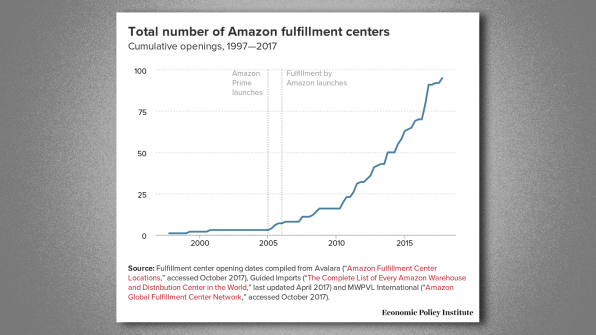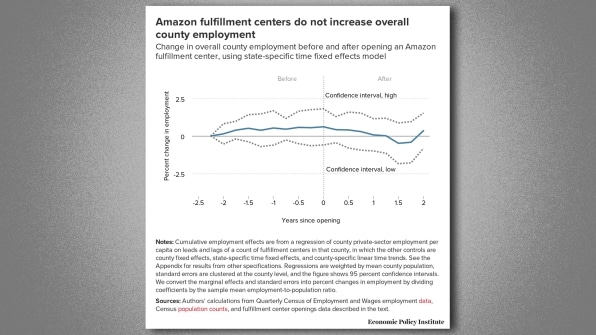As officials bend over backward to woo Amazon to locate a second headquarters in their cities, critics have often questioned whether you can go too far to lure an internet giant. While Amazon is offering perhaps 50,000 new tech jobs and billions in investment, they wonder who is really getting the better deal as cities promise a chocolate box full of tax breaks, free land, and other subsidies. (The Atlanta suburb of Stonecrest, in a truly transparent display of potential obsequiousness to its future corporate overlords, even offered to rename itself “Amazon” and to make Jeff Bezos mayor-for-life.)
It’s hard to predict whether the sweeteners will pay off, but if the past is any guide, cities should perhaps be wary. A new report looking at the employment outcomes of Amazon fulfillment centers finds little or no net improvement in jobs over time. While a new center does produce, on average, a 30% increase in storage and warehousing jobs within two years, according to a report from the Economic Policy Institute, there is little evidence of an overall uptick in employment. The researchers say the gains are either offset by losses in other industries or that they don’t register enough to make a dent in the data.
“Our findings..suggest that some sort of employment displacement is taking place, or that the growth in warehousing jobs is too limited to spill over into broad-based employment gains for the overall local economy,” the report, by Janelle Jones and Ben Zipperer, says.

Amazon has built about 100 distribution centers around the country in the last two decades, but Jones and Zipperer limited their sample to the 2001–2015 period. They looked specifically at 54 centers in 34 counties, comparing logistics employment among 1,161 counties across the country to understand Amazon’s impact. It was basically a wash. “We find that opening an Amazon fulfillment center does lead to gains in warehouse jobs in a county, but does not lead to gains in overall county-level employment,” the report says.
Data from Good Jobs First, a nonprofit that tracks economic development subsidies, shows that Amazon has received a total of more than $1.2 billion in tax abatements, credits, infrastructure improvements and training grants from state and local governments over its lifetime. The centers have spread rapidly in recent years, as Amazon has ramped up its next-day delivery services and expanded its Prime business.
Responding to the report, Amazon says the EPI–a left-of-center Washington D.C. think-tank–has cherrypicked its numbers. By focusing on the 2001–2015 period, the research takes in the recession, when job numbers were falling anyway, the company says, and Amazon wasn’t building as many centers as it has more recently. That said, the level of subsidies it has received has kept on going up, as Good Jobs First documented in a special 2016 report.

Moreover, research by The Economist finds that Amazon fulfillment centers tend to pay less well compared to other employers offering the same jobs. “Government figures show that after Amazon opens a storage depot, local wages for warehouse workers fall by an average of 3%,” the magazine concluded in January. “In places where Amazon operates, such workers earn about 10% less than similar workers employed elsewhere.”
Economists tend to question the wisdom of showering come-hither subsidies on companies. A recent petition signed by 600 academics and urbanists called for a “mutual non-aggression pact” among cities to stop the subsidy arms race, and particularly for the end to the “egregious tax giveaways and direct monetary incentives for the Amazon headquarters.” Good Jobs First has called for cities to make full disclosure of their packages in hopes of bringing transparency to the process.
For now, such calls are falling on deaf ears. Amazon recently announced a shortlist of 20 winners to its HQ2 horserace, all of which are offering generous giveaways. But, if there’s one silver lining, it’s perhaps that the contest has started a fuller debate. More people are now asking whether paying companies to build operations–what they do anyway–is really worth spending public money on.
Fast Company , Read Full Story
(51)